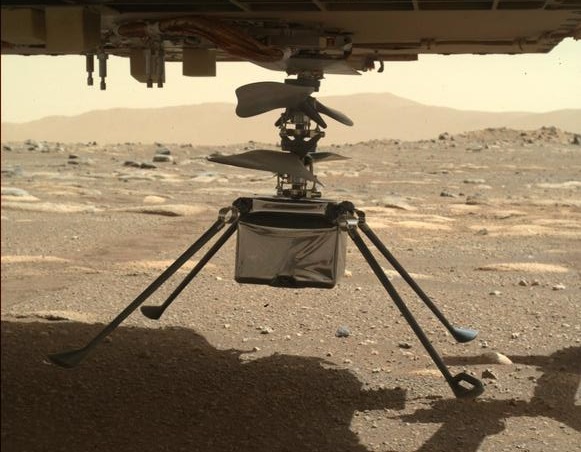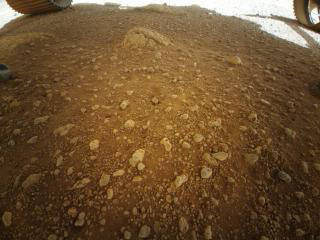NASA's Mars helicopter Ingenuity has survived its first Martian night alone as 1st test flight looms

NASA's Mars helicopter Ingenuity has survived its first frigid night alone on the Red Planet.
The agency's Perseverance rover, which landed safely in Jezero Crater on the Martian surface Feb. 18, has been carrying Ingenuity in its belly as mission teams prepare for the craft's first flight, which is set to take place no sooner than April 11. On Saturday (April 3), in the next step toward the flight, the rover dropped Ingenuity onto the surface of Mars, where it would have to survive temperatures as low as minus 130 degrees Fahrenheit (minus 90 degrees Celsius).
However, despite the fact that these extreme temperatures could freeze and crack the craft's onboard batteries or other electrical components, the 4-lbs. (1.8-kilograms) helicopter survived its first chilly night, NASA's Jet Propulsion Laboratory announced today (April 5).
"We actually survived the first night. That is huge, that was one of the huge, huge achievements that we’ve been looking forward to," Teddy Tzanetos, Ingenuity deputy operations lead, said during a live Q&A session today.
"Being able to drop under our own energy, sustain ourselves, keep ourselves warm throughout the night, and then wake up and talk with Perseverance and say, 'Yep, we're here. We're alive and healthy.' The team couldn't be happier," Tzanetos added.
Video: Watch NASA's Mars helicopter unfold like a butterfly
The solar-powered helicopter flew to the Red Planet tucked safely under NASA's Perseverance rover. Since the rover successfully landed in Jezero Crater, the mission team has been preparing for Ingenuity's historic first flight, which will be the first helicopter flight on another world.
Breaking space news, the latest updates on rocket launches, skywatching events and more!
First, the team had to find the right area, or airfield, for the craft to take flight. "We found a perfect location," Vandi Verma, Perseverance chief engineer for robotic operations, said during a flight preview webinar today. "It meets all the requirements of the airfield that we wanted: it's nice and flat, and it has just the right amount of rocks — we wanted some amount of rocks so that the cameras on the helicopter can do good feature detection — but good landing spots could be identified and also the slopes were appropriate."
Once the airfield was selected together with the Perseverance mission team, the craft began to slowly unfold from beneath the rover. Most recently,on Saturday, the helicopter finally touched down after Perseverance dropped it 4 inches (10 centimeters) to the Martian surface (on purpose, of course).
"We've been unfolded, our legs have been deployed, we went vertical and very recently, we were just dropped onto the surface for the first time and now we're on our own," Tzanetos said, speaking for the team and the helicopter as "we."
After the deployment but while the craft was still under Perseverance's "belly," Ingenuity actually snapped its first photo, a "heli-belly" picture, Tm Canham, Mars Helicopter operations lead, joked during the webinar.
With this big milestone, the helicopter went from relying on Perseverance for power to being completely on its own, powered only by its own solar arrays. So this test was a major step forward in the mission, as the team now knows that the helicopter can collect its own energy to survive.
There are still a number of tasks that the mission team will have to accomplish before Ingenuity is ready to fly. First, the team will charge the craft using its solar array and ensure that it is collecting and using energy and power as they anticipate. This is critical, as energy from the craft's solar array will both keep it warm overnight and power it for flight.
Next, the team will unlock the helicopter's blades, MiMi Aung, Mars Helicopter Project Manager, said during the live Q&A. While in flight the craft's four blades will spin counter to each other, as you would expect from a helicopter, but to release and "unlock" them, the team will rotate them in the same direction. The team will then actually spin the rotor blades for the first time, slowly at just about 50 revolutions per minute, Aung said, and then at full speed, about 2,400 rpm.
After the successful completion of these steps, the team will have Ingenuity lift up and fly for the first time, hover autonomously for about 30 seconds and then land. The helicopter will reach about 15 feet (4.6 meters) in the sky with this flight, Tzanetos said.
With the success of its inaugural flight, the Ingenuity mission team will fly the craft four more times within the 30 sols, or Mars days, (about 31 Earth days) anticipated for the mission. The average flight length will be about 90 seconds, according to Tzanetos.
But for now, the Ingenuity team is just thrilled that the helicopter has made it so far, surviving one of the biggest (and coldest) challenges of its mission. "Our team is over the moon," Aung said.
Email Chelsea Gohd at cgohd@space.com or follow her on Twitter @chelsea_gohd. Follow us on Twitter @Spacedotcom and on Facebook.

Chelsea “Foxanne” Gohd joined Space.com in 2018 and is now a Senior Writer, writing about everything from climate change to planetary science and human spaceflight in both articles and on-camera in videos. With a degree in Public Health and biological sciences, Chelsea has written and worked for institutions including the American Museum of Natural History, Scientific American, Discover Magazine Blog, Astronomy Magazine and Live Science. When not writing, editing or filming something space-y, Chelsea "Foxanne" Gohd is writing music and performing as Foxanne, even launching a song to space in 2021 with Inspiration4. You can follow her on Twitter @chelsea_gohd and @foxannemusic.

